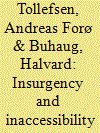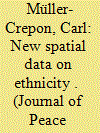|
|
|
Sort Order |
|
|
|
Items / Page
|
|
|
|
|
|
|
| Srl | Item |
| 1 |
ID:
087483


|
|
|
|
|
| Publication |
2009.
|
| Summary/Abstract |
This article explores to what extent the security dilemma through geographically induced first-strike advantages is a contributing cause of ethnic warfare. If there are possibly decisive advantages to be gained from striking the first blow, both temptation and fear may shortcut efforts to resolve a conflict in less costly ways, and trigger massive violence. Theoretical work and case studies suggest that in ethnic conflicts intermingled settlement patterns give rise to such first-strike advantages. I test whether ethnic groups in conflict are more likely to become involved in ethnic warfare if their main region of settlement is ethnically diverse. I also include controls intended to capture other aspects of the security dilemma. In robustness tests, I add indicators of group concentration and local majority status that have been found to increase the risk of ethnic violence in previous quantitative studies. I find a strong, statistically significant association between regional ethnic diversity and ethnic warfare.
|
|
|
|
|
|
|
|
|
|
|
|
|
|
|
|
| 2 |
ID:
137750


|
|
|
|
|
| Summary/Abstract |
A widely held belief within policy and practice contends that rough terrain and other physical obstacles to power projection hinder public surveillance, lower counterinsurgency capability, and generally constitute an important facilitator of rebellion. Likewise, sociocultural exclusion and alienation from the core are widely assumed to increase latent conflict risk through their influence on identity formation and perception of collective grievances. However, there is no scientific consensus on the empirical strength or significance of such a relationship, and many quantitative studies fail to find a robust link between a country's geographical or ethno-demographic characteristics and its estimated conflict risk. This paper represents a first comprehensive evaluation of how physical and sociocultural inaccessibility relate to contemporary civil wars. Drawing on recent advances in geographic information systems and georeferenced indicators of terrain, settlement patterns, ethno-political status, and armed conflict, we put the purported causal relationship to empirical test. A statistical analysis of civil-conflict events across post-Cold War Africa gives considerable support to the proposed theoretical framework, revealing that the various dimensions of inaccessibility all exert significant and substantive effects on local conflict risk. We find weaker evidence for the notion of substitutability; the inaccessibility indicators largely retain their individual effects when included in the same regression model.
|
|
|
|
|
|
|
|
|
|
|
|
|
|
|
|
| 3 |
ID:
161556


|
|
|
|
|
| Summary/Abstract |
Research on ethnic politics and political violence has benefited substantially from the growing availability of cross-national, geo-coded data on ethnic settlement patterns. However, because existing datasets represent ethnic homelands using aggregate polygon features, they lack information on ethnic compositions at the local level. Addressing this gap, this article introduces the Spatially Interpolated Data on Ethnicity (SIDE) dataset, a collection of 253 near-continuous maps of local ethno-linguistic, religious and ethno-religious settlement patterns in 47 low- and middle-income countries. We create these data using spatial interpolation and machine learning methods to generalize the ethnicity-related information in the geo-coded Demographic and Health Surveys (DHS). For each DHS survey we provide the ethnic, religious and ethno-religious compositions of cells on a raster that covers the respective countries at a resolution of 30 arc-seconds. The resulting data are optimized for use with geographic information systems (GIS) software. Comparisons of SIDE with existing categorical datasets and district-level census data from Uganda and Senegal are used to assess the data’s accuracy. Finally, we use the new data to study the effects of local polarization between politically relevant ethnic groups, finding a positive effect on the risk of local violence such as riots and protests. However, local ethno-political polarization is not statistically associated with violent events pertaining to larger-scale processes such as civil wars.
|
|
|
|
|
|
|
|
|
|
|
|
|
|
|
|
| 4 |
ID:
147669


|
|
|
|
|
| Summary/Abstract |
Our understanding of the transition from the last centuries of prehistory to the Pre-Angkorian period in northeast Thailand has been limited by a lack of projects bridging both periods. This article examines settlement patterns of the first to the ninth centuries CE in the Upper Mun River Valley based on recent (2012–14) surveys. The findings highlight the gradual settlement trends in the region, with a focus on local modification rather than the sudden adoption of external ideas. Results reinforce the fourth to sixth centuries CE as a pivotal period, when large centres consolidated and cautiously expanded upriver, into previously uninhabited regions. A relatively modest, flexible, and resilient settlement strategy developed, attuned to wider supra-regional trends, but allowing for the demands of the local cultural and physical landscape.
|
|
|
|
|
|
|
|
|
|
|
|
|
|
|
|
|
|
|
|
|